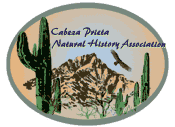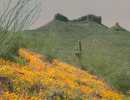
Cabeza Prieta Natural History Association
Sonoran Desert Mammals

Western pipistrelle
(Pipistrellus hesperus hesperus )

|
Diet: caddisflies, stoneflies, moths, small beetles, leaf and stilt bugs, leafhoppers, flies, mosquitoes, ants, and wasps
Color: pale yellow or gray to reddish-brown above, whitish below Size: weight 3-6 grams (0.1-0.2 ounce) wingspan 19-23 centimeters (7-9 inches) Active Period: nocturnal, but may begin foraging flights before sunset, and may remain active well after dawn Abundance: common |
The western pipestrelle bat is one of the smallest bats in the United States. Primarily a desert species, it inhabits a variety of habitats from rocky canyons, cliffs, and outcroppings to creosote bush flats. Day roosts usually are in rock crevices, but may be beneath rocks, in burrows and in mines. It tends to roost singly or in small groups; a maternity colony of 12 individuals is the largest know group of this species. In winter, it has been found hibernating in mines, caves, and rock crevices.
It is among the most diurnal of all bats. However, except for lactating females that may be active throughout the night, early evening activity usually ceases within 1-2 hours after sunset.
The flight is fluttery and is among the slowest and weakest of all bats. A slight breeze can bring these bats to a standstill, and a stronger wind may cause them to seek shelter.
The western pipestrelle forages 2-25 meters (7-82 feet) above ground on swarming insects, and consumes about 20% of its body weight per feeding.
Twins are born in June or July, after a gestation period of about 40 days. Newborn bats weight less than 1 gram, but they grow quickly. Juveniles begin to fly at about 1 month of age.
This article is from "Bats of the United States", 1999, by Michael J. Harvey of Tennessee Technological University, J. Scott Altenbach of the University of New Mexico, and Troy L. Best of Auburn University. Published by the Arkansas Game & Fish Commission, in cooperation with the Asheville Field Office of the U.S. Fish and Wildlife Service.
Photo Credit:
Photo #1
Copyright Creative Commons
HTML & Programing by
Thomas R. Powell